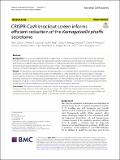| dc.contributor.author | Dalvie, Neil C. | |
| dc.contributor.author | Lorgeree, Timothy R. | |
| dc.contributor.author | Yang, Yuchen | |
| dc.contributor.author | Rodriguez-Aponte, Sergio A. | |
| dc.contributor.author | Whittaker, Charles A. | |
| dc.contributor.author | Hinckley, Joshua A. | |
| dc.contributor.author | Clark, John J. | |
| dc.contributor.author | Del Rosario, Amanda M. | |
| dc.contributor.author | Love, Kerry R. | |
| dc.contributor.author | Love, J. C. | |
| dc.date.accessioned | 2024-08-06T17:12:37Z | |
| dc.date.available | 2024-08-06T17:12:37Z | |
| dc.date.issued | 2024-07-31 | |
| dc.identifier.uri | https://hdl.handle.net/1721.1/155951 | |
| dc.description.abstract | Background
The yeast Komagataella phaffii is widely used for manufacturing recombinant proteins, but secreted titers of recombinant proteins could be improved by genetic engineering. In this study, we hypothesized that cellular resources could be redirected from production of endogenous proteins to production of recombinant proteins by deleting unneeded endogenous proteins. In non-model microorganisms such as K. phaffii, however, genetic engineering is limited by lack gene annotation and knowledge of gene essentiality.
Results
We identified a set of endogenous secreted proteins in K. phaffii by mass spectrometry and signal peptide prediction. Our efforts to disrupt these genes were hindered by limited annotation of essential genes. To predict essential genes, therefore, we designed, transformed, and sequenced a pooled library of guide RNAs for CRISPR-Cas9-mediated knockout of all endogenous secreted proteins. We then used predicted gene essentiality to guide iterative disruptions of up to 11 non-essential genes. Engineered strains exhibited a ~20× increase in the production of human serum albumin and a twofold increase in the production of a monoclonal antibody.
Conclusions
We demonstrated that disruption of as few as six genes can increase production of recombinant proteins. Further reduction of the endogenous proteome of K. phaffii may further improve strain performance. The pooled library of secretome-targeted guides for CRISPR-Cas9 and knowledge of gene essentiality reported here will facilitate future efforts to engineer K. phaffii for production of other recombinant proteins and enzymes. | en_US |
| dc.publisher | BioMed Central | en_US |
| dc.relation.isversionof | 10.1186/s12934-024-02466-2 | en_US |
| dc.rights | Creative Commons Attribution | en_US |
| dc.rights.uri | https://creativecommons.org/licenses/by/4.0/ | en_US |
| dc.source | BioMed Central | en_US |
| dc.title | CRISPR-Cas9 knockout screen informs efficient reduction of the Komagataella phaffii secretome | en_US |
| dc.type | Article | en_US |
| dc.identifier.citation | Dalvie, N.C., Lorgeree, T.R., Yang, Y. et al. CRISPR-Cas9 knockout screen informs efficient reduction of the Komagataella phaffii secretome. Microb Cell Fact 23, 217 (2024). | en_US |
| dc.contributor.department | Massachusetts Institute of Technology. Department of Chemical Engineering | |
| dc.contributor.department | Koch Institute for Integrative Cancer Research at MIT | |
| dc.contributor.department | Massachusetts Institute of Technology. Department of Biological Engineering | |
| dc.relation.journal | Microbial Cell Factories | en_US |
| dc.identifier.mitlicense | PUBLISHER_CC | |
| dc.eprint.version | Final published version | en_US |
| dc.type.uri | http://purl.org/eprint/type/JournalArticle | en_US |
| eprint.status | http://purl.org/eprint/status/PeerReviewed | en_US |
| dc.date.updated | 2024-08-04T03:14:18Z | |
| dc.language.rfc3066 | en | |
| dc.rights.holder | The Author(s) | |
| dspace.date.submission | 2024-08-04T03:14:18Z | |
| mit.license | PUBLISHER_CC | |
| mit.metadata.status | Authority Work and Publication Information Needed | en_US |
